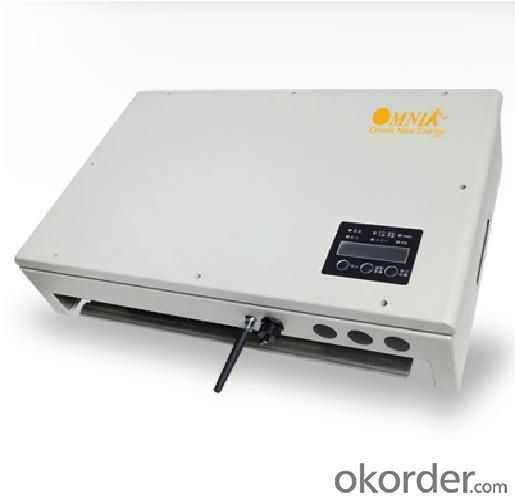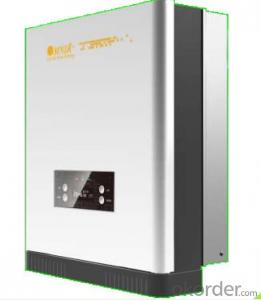On grid solar inverter Omniksol-4.0k-JP
- Loading Port:
- Shanghai
- Payment Terms:
- TT OR LC
- Min Order Qty:
- 1 pc
- Supply Capability:
- 3000 pc/month
OKorder Service Pledge
OKorder Financial Service
You Might Also Like
Omnik new energy solar inverter
Omniksol-2.0k-TL Photon Efficiency up to 3kW
in the world------ Photon tested Jan. 2012.
Omniksol-4k-JP
Futures
Omniksol-4k-JP PV inverter ,featuring two MPPT tracker, maximum converstaion efficiency 96.2%,off-grid to on grid mutual switch , IP 65 Protection design, easy installation , is special designed for Janpan consumer.
1.Features
Transformer design, high frequency isolation technology with high security
High efficiency (Max.96.2%), High MPPT accuracy(>99.9%)
2 MPPT design, reach the maximum output power
Wide DC input range (95-420 Vdc),lower start voltage 65Vdc
on-grid/ off grid switch function
IP 65 design, suitable for indoor and outdoor installation
10 years warranty(10~25 years as option)
2.Technical data:
Inverter Type | Omniksol-3k-TL | Omniksol-4k-TL | Omniksol-5k-TL | |
| Input(DC) | Max.PV Input voltage[V] | 450 | ||
| Input Voltage Range(MPPT)[V] | 95-420 | |||
| Operation voltage Range[V] | 75-420 | |||
| Rating Input voltage[V] | 280 | |||
| Wake Up voltage[V] | 65 | |||
| Number of MPPT Trackers | 2 | |||
| Input Power Limitation[W] | 1600 | 2100 | 2600 | |
| Input Current Limitation[A] | 8 | 10 | 12 | |
| MPPT Efficiency | 99.90% | |||
| Efficiency | >96% | >96% | >96.2% | |
| Input Switch[A] | 8 | 10 | 12 | |
3. Omniksol-4k-JP
JET
ISO
CE
4. product outlook

FAQ
1. How long will my inquiry get response?
Your inquiry related to our products or prices will be replied within 24 hours.
2. Can I get professional service and suggestion?
Well-trained and experienced staffs to answer all your questions in fluent English.
3. Do you accept OEM or customized design?
OEM & ODM, any your customized lightings we can help you to design and put into product.
4. What if I need specific design?
Distributorship are offered for your unique design and some our current models.
- Q:How does a solar inverter handle variations in battery charge levels?
- A solar inverter manages variations in battery charge levels by monitoring the voltage and state of charge of the batteries. It adjusts the flow of electricity from the solar panels to the batteries accordingly, ensuring that the batteries are charged optimally without overcharging or undercharging. This helps maintain a stable and efficient energy storage system.
- Q:The working principle of photovoltaic grid - connected inverter
- Full-bridge inverter circuit to overcome the shortcomings of the push-pull circuit, the power transistor to adjust the output pulse width, the output AC voltage RMS that changes. Since the circuit has a freewheeling circuit, even if the inductive load, the output voltage waveform will not be distorted. The disadvantage of this circuit is that the upper and lower arms of the power transistor are not common, so you must use a special drive circuit or use isolated power supply. In addition, in order to prevent the upper and lower arm co-conduction, must be designed to turn off after the conduction circuit, that must be set dead time, the circuit structure is more complex.
- Q:What is the typical size and weight of a solar inverter?
- The typical size and weight of a solar inverter can vary depending on its power capacity. Generally, residential solar inverters range in size from around 30 x 50 x 20 cm (12 x 20 x 8 inches) to 60 x 60 x 30 cm (24 x 24 x 12 inches) and weigh between 10 kg (22 lbs) to 25 kg (55 lbs). Commercial or utility-scale inverters, on the other hand, can be much larger and heavier, weighing several hundred kilograms (or even tons) and occupying larger spaces.
- Q:What are the potential risks of overloading a solar inverter?
- The potential risks of overloading a solar inverter include overheating, reduced lifespan of the inverter, and even permanent damage to the equipment. Overloading can also result in power fluctuations and instability in the electrical system, leading to potential safety hazards. It is crucial to ensure that the solar inverter is appropriately sized and capable of handling the electrical load to avoid these risks.
- Q:Can a solar inverter be used in extreme weather conditions?
- Yes, solar inverters are designed to withstand extreme weather conditions. They are built to be durable and resistant to factors such as temperature fluctuations, humidity, and harsh weather elements. However, it is always recommended to consult the manufacturer's guidelines to ensure proper installation and protection measures are in place for specific weather conditions.
- Q:Can a solar inverter be used with a solar-powered educational system?
- Yes, a solar inverter can be used with a solar-powered educational system. A solar inverter is responsible for converting the direct current (DC) produced by solar panels into alternating current (AC) that can be used to power electrical devices. In the case of a solar-powered educational system, the solar inverter plays a crucial role in converting the DC energy generated by the solar panels to AC energy that can be utilized by the educational equipment, such as computers, projectors, or other electrical devices, thereby enabling the system to function efficiently.
- Q:What is the role of a solar inverter in a residential system?
- The role of a solar inverter in a residential system is to convert the direct current (DC) electricity generated by the solar panels into alternating current (AC) electricity that is suitable for use in the home. It also manages the flow of electricity, monitors the system's performance, and ensures safety by providing protection against electrical faults.
- Q:What is the lifespan of the capacitors in a solar inverter?
- The lifespan of capacitors in a solar inverter can vary depending on several factors such as the quality of the capacitors, the operating conditions, and the overall design of the inverter. However, on average, high-quality capacitors in a well-designed solar inverter can have a lifespan of around 10 to 15 years. Regular maintenance and proper usage can help extend the lifespan of the capacitors in a solar inverter.
- Q:What is the operating temperature range of a solar inverter?
- The operating temperature range of a solar inverter typically falls between -20°C to 50°C (-4°F to 122°F), although this can vary depending on the specific model and manufacturer.
- Q:What is the role of a voltage regulation feature in a solar inverter?
- The role of a voltage regulation feature in a solar inverter is to ensure that the voltage output from the solar panels is maintained at a stable and optimal level. This helps to protect the sensitive electrical components in the solar inverter and other connected devices, while also maximizing the efficiency and performance of the solar power system.
1. Manufacturer Overview |
|
|---|---|
| Location | |
| Year Established | |
| Annual Output Value | |
| Main Markets | |
| Company Certifications | |
2. Manufacturer Certificates |
|
|---|---|
| a) Certification Name | |
| Range | |
| Reference | |
| Validity Period | |
3. Manufacturer Capability |
|
|---|---|
| a)Trade Capacity | |
| Nearest Port | |
| Export Percentage | |
| No.of Employees in Trade Department | |
| Language Spoken: | |
| b)Factory Information | |
| Factory Size: | |
| No. of Production Lines | |
| Contract Manufacturing | |
| Product Price Range | |
Send your message to us
On grid solar inverter Omniksol-4.0k-JP
- Loading Port:
- Shanghai
- Payment Terms:
- TT OR LC
- Min Order Qty:
- 1 pc
- Supply Capability:
- 3000 pc/month
OKorder Service Pledge
OKorder Financial Service
Similar products
New products
Hot products
Hot Searches
Related keywords






























